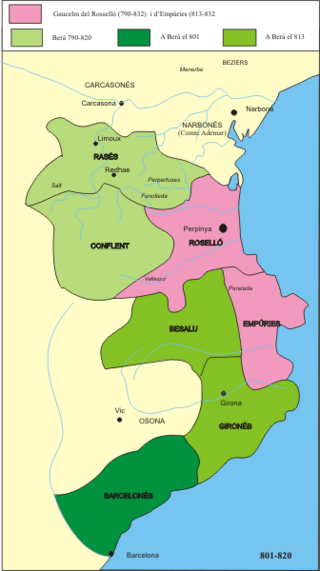Bernardof Septimania (795–844), son of William of Gellone and cousin of Charlemagne, was the Duke of Septimania and Count of Barcelona from 826 to 832 and again from 835 to his execution, and also Count of Carcassonne from 837. He was appointed to succeed the third Count of Barcelona, Rampon. During his career, Bernard was one of the closest counsellors of the Emperor Louis the Pious, a leading proponent of the war against the Moors, and was an opponent of the interests of the local Visigothic nobility in Iberia.

Sunifred was the Count of Urgell and Cerdanya from 834 to 848, and the Count of Barcelona as well as many other Catalan and Septimanian counties, including Ausona, Besalú, Girona, Narbonne, Agde, Béziers, Lodève, Melgueil, Conflent and Nîmes, from 844 to 848.

The County of Barcelona was a polity in northeastern Iberian Peninsula, originally located in the southern frontier region of the Carolingian Empire. In the 10th century, the Counts of Barcelona progressively achieved independence from Frankish rule, becoming hereditary rulers in constant warfare with the Islamic Caliphate of Córdoba and its successor states. The counts, through marriage, alliances and treaties, acquired or vassalized the other Catalan counties and extended their influence over Occitania. In 1164, the County of Barcelona entered a personal union with the Kingdom of Aragon. Thenceforward, the history of the county is subsumed within that of the Crown of Aragon, but the city of Barcelona remained preeminent within it.
Bernard II was the count of Barcelona, Girona and margrave of Gothia and Septimania from 865 to 878.
Gausbert was the count of Empúries and Rosselló from 915 until he died. He was the son of Sunyer II of Empúries and brother of Bencion.

Oliba Cabreta was the count of Cerdanya from 965 and count of Besalú from 984 until his abdication in 988.

The County of Besalú was one of the landlocked medieval Catalan counties near the Mediterranean coastline. It was roughly coterminous with the modern comarca of Garrotxa and at various times extended as far north as Corbières, Aude, now in France. Its capital was the village of Besalú. Throughout most of its history it was attached to one of the other more powerful counties, but it experienced a century of independence before it was finally and irrevocably annexed to the County of Barcelona.
The County of Carcassonne was a medieval fiefdom controlling the city of Carcassonne, France, and its environs. It was often united with the County of Razès.
The County of Cerdanya was one of the Catalan counties formed in the last decades of the 8th century by the Franks in the Marca Hispanica. The original Cerdanya consisted of the valley of the upper Segre. Today Cerdanya is a Catalan comarca.
Acfred II was the co-governor of the County of Carcassonne and Razès from 906 to 908 and then count in his own right until his death. He was the younger son of Oliba II of Carcassonne and he cogoverned his inheritance with his elder brother Bencion I of Carcassonne. He has been identified with Acfred, Duke of Aquitaine, but this identification is now considered unlikely.
Bello was Count of Carcassonne from 790 until his death. He was the founder of the Bellonid Dynasty of Carcassonne and Razès which reached its apex in Wilfred the Hairy, progenitor of the House of Barcelona.
Guisclafred was the Count of Carcassonne from 810. He was the eldest son and successor of Bello of Carcassonne. His brothers were Sunyer I of Ampurias, Sunifred I of Barcelona, and Oliba I of Carcassonne.
Bernard II, known as the Calf, was the count of Toulouse, Rouergue, Limoges, Nîmes, Carcassonne, Razès, and Albi. He was the son of Raymond I and Bertha. The dates of his reign are disputed: either 865–877 or 864–872.
Acfred I was the Count of Razès from 837 and Count of Carcassonne from 877.

The County of Conflent or Confluent was one of the Catalan counties of the Marca Hispanica in the ninth century. Usually associated with the County of Cerdanya and the county of Razès, it was located to the west of Roussillon. It largely corresponded to the modern comarca of Conflent.

Bernard I, called Taillefer, was the Count of Besalú in Catalonia from 988 until his death. He was the eldest son of Oliba Cabreta and Ermengard of Empúries, and succeeded his father in Besalú while his younger brothers Oliba and Wifred, inherited Berga–Ripoll and Cerdagne–Conflent, respectively. He was the great-grandson of Wilfred the Hairy, and therefore belonged to the House of Barcelona.
Wilfred or Wifred, called the Hairy, was Count of Urgell, Cerdanya, Barcelona, Girona, Besalú and Ausona. On his death in 897, his son, Wilfred Borrell, inherited these Catalan counties.
Miró II of Cerdanya and I of Besalú (878?–927), was count of Cerdanya from 897 to 927 and of Besalú from 920 to 927. The lands he controlled lay in the eastern Pyrenees.

Ava of Cerdanya was countess consort of Cerdanya and Besalú. She ruled as regent during the minority of her sons from 927 until 941.
Miró III of Cerdanya and II of Besalú, Bonfill, was count of Cerdanya and Besalú (968–984).






